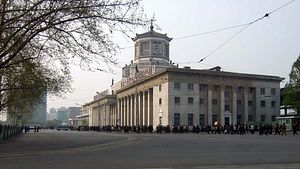North Korea made a rare apology over the weekend for an apartment building that collapsed in Pyongyang.
According to a report in the English-language version of the Korean Central News Agency (KCNA), North Korea’s state media, “there occurred a serious accident in the construction site in Phyongchon District, Pyongyang on May 13 as the construction of an apartment house was not done properly and officials supervised and controlled it in an irresponsible manner. The accident claimed casualties.”
The report continued: “Right after the accident the state emergency mechanism was put into action to conduct an intensive campaign to rescue survivors, treat the wounded and arrange the scene of the accident. The rescue operation came to an end on May 17.”
KCNA went on to name a number of individuals as at fault for the building collapse. They included: “Minister of People’s Security Choe Pu Il, General Officer of the Korean People’s Internal Security Forces Sonu Hyong Chol, Chairman of the Pyongyang City People’s Committee Cha Hui Rim, and Chief Secretary of Phyongchon District Committee of the WPK Ri Yong Sik.” The report featured each man apologizing for contributing to the building collapse.
KCNA did not reveal the number of people killed or injured in the collapse of the under-construction apartment building. However, an unnamed South Korean government official told Yonhap News Agency: “”In North Korea, it is common that people move into a new apartment even before the construction is completed. About 92 households may have been living in the apartment.” The same Yonhap report said the building was around 23 stories tall. Satellite image courtesy of North Korean Economy Watch collaborates that claim.
A different story Yonhap carried on Monday reported, citing KCNA, that North Korean leader Kim Jong-un had visited the hospital where injured people from the building collapse were being treated. He was accompanied by his wife, Ri Sol-ju, and two senior officials, including Lt. Gen. Ma Won-chun, director of the Designing Department of the National Defense Commission, according to Yonhap.
The original KCNA report said that “Kim Jong Un sat up all night, feeling painful after being told about the accident, instructed leading officials of the party, state and the army to rush to the scene, putting aside all other affairs, and command the rescue operation to recover from the damage as early as possible.”
It is rare, although not unprecedented, for the Workers’ Party of Korea and the North Korean government to admit fault for an incident and apologize. Thus, the incident raises the question of why North Korea felt compelled to do so on this occasion.
The most obvious answer is that the building collapse must have killed an inordinate number of people. The North Korean government is only likely to issue an apology if it feels that it must. Thus, the sheer number of people killed in the collapse must have created concern that the incident could spark serious unrest unless the government got in front of it. Given that it took days after the building collapsed for the story to be reported, it’s possible that there were already signs of unrest in the capital city, which prompted the North Korean government to acknowledge fault and apologize.
The incident also highlights the different ways the North Korean government treats Pyongyang versus the rest of the country. Nearly all North Koreans living in Pyongyang are members of the elite. This is almost certainly doubly true of families living in new high rise apartment buildings. Kim Jong-un has spent his short time in office trying to shore up support for the new regime among the party elite. This is evident from, among other things, his construction of amusement parks and ski resorts, which only the Pyongyang elite would be able to afford.
As North Korean Economy Watch points out, the building that collapsed was part of the much vaulted (but largely delayed) effort to build 100,000 new homes as part of the celebrations surrounding Kim Il-Sung’s 100th birthday in 2012. The NKEW also notes, “The neighborhood in which the collapsed building is located contains no less than 17 high-rises that are either under construction or recently completed. If I was living in one of these buildings I would not be feeling very confident right now.” Thus, the decision to issue an apology may have been aimed at reassuring those living in other new high-rise buildings that the collapse was an isolated event.
This bodes poorly for the individuals quoted by KCNA as taking responsibility for the building’s collapse. They are almost certain to face a public trial and harsh punishment, possibly even including execution.

































